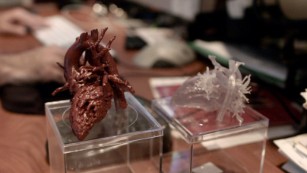'The biggest secret that nobody knows about'
The models can also help train medical students and explain complicated procedures to patients such as Mia and her family.
Eventually,
the printers could be used to produce actual organs that can be
transplanted into patients; just replace the rubber and plastic printer
"ink" with human cells.
"We are going to see massive advances in the next five to 10 years of how to take the technology to this point," Rader said.
Simulated
organs are "a disruptive technology which radically changes how we talk
to patients, how we prepare for an operation, how we do the operation
and how we teach," said Dr. Daniel B. Jones, professor of surgery at
Harvard Medical School and co-director of the Simulation and Skills
Center at Beth Israel Deaconess Medical Center in Boston.
However, the technology is not widely in use in hospitals or medical schools yet.
"This
is like the biggest secret that nobody knows about," said Jones, who
has done research on surgeons' impressions of using simulated organs.
Even those who do know about the technology might feel uncomfortable
showing patients a model of their tumor, for example, and discussing it
with them in depth.
Hospitals are starting to invest in the technology, which is more realistic now that prices have come down, Jones said.
The
printer and software usually cost in the range of $100,000, which is
less than a CT scan or MRI setup, Rader said. He predicts that interest
in the technology will continue to grow as research shows how using
simulated organs leads to better surgical outcomes and shorter operating
times.
The models have also been
invaluable in helping patients and their families feel confident that
they are doing the right thing, said Burke, who operated on Mia.
Seeing
the model "made it seem like a simple surgery, it put you at ease,"
said Gonzalez, Mia's mom. "(Mia) was used to hospitals and IVs, but to
explain that you're going to have surgery and be in pain, that is all
different," and the model helped put it in perspective, she said.
Four
months later, the surgery seems like ancient history to Mia. She has
forgotten all about her surgical scar, her mother said, and had little
pain. Although she has had some minor colds, none has landed her in the
hospital. A month later, she was even able to participate in her dance
recital.











0 comments:
Post a Comment